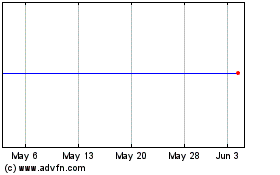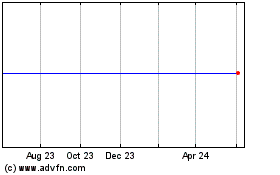Bank of Montreal's (BMO) fiscal first-quarter earnings rose
18%,, just beating market expectations, as continued strength in
the Canadian economy led to lower loan-loss provisions and fueled
trading and underwriting activity.
Net income at Canada's fourth-largest bank in assets rose to
C$776 million, or C$1.30 a share, in the quarter ended Jan. 31,
from C$657 million, or C$1.12, a year earlier, the bank said in a
statement. Cash earnings of C$1.32 a share were up from C$1.13 a
year ago and just topped the C$1.31 mean estimate from analysts
polled by Thomson Reuters. Revenue rose 11% to C$3.35 billion.
Bank of Montreal, the third of Canada's biggest six lenders to
report its results, benefited from an economy that expanded at a
faster-than-expected 3.3% pace from October to December. Loan-loss
provisions declined 26%, while personal and commercial revenues in
Canada remained robust, rising 9%, helped by the inclusion of the
Diners Club North American card portfolio. Rallying equity markets
boosted mutual fund sales and underwriting activity. Profit at its
investment bank jumped 21% on higher trading revenue and merger and
acquisition advisory and underwriting fees.
"It was a very solid performance," said Tommy Nguyen, senior
portfolio manager at Palos Management Inc. in Montreal. "Their
market-sensitive revenues were strong, better than expected."
In Toronto Tuesday, BMO closed down 19 Canadian cents to C$61.77
on more than 3.1 million shares traded.
Loan-loss provisions fell to C$248 million from C$333 million a
year earlier.
In Canada, profit at the bank's personal and commercial banking
unit rose 10% to C$444 million from volume growth across most
products and improved net interest margin. The division's
credit-loss provisions rose 13% from a year ago from portfolio
growth and the addition of the Diners Club business and climbed 3%
from the previous quarter, which BMO attributed to the holiday
shopping season. That generally tends to reverses in the second
quarter because of income tax refunds, it said.
Canadians are carrying personal debtloads that now surpass the
Americans, prompting Bank of Canada Governor Mark Carney repeatedly
to warn that household debt levels are too high and Finance
Minister Jim Flaherty to introduce new mortgage rules to curb their
appetite.
"It's a balancing act for the consumer and the bank," said BMO
Chief Executive William Downe in an interview.
"We expect to see moderation in consumer loan growth. It's a
healthy thing for the economy and our customers. So, we've been
spending a lot of time talking to them about making sure they're
buying the right house with the right loan."
"We will still have positive (loan) growth but at a lower
level," he said.
In the U.S., where BMO has struggled and is expanding through
acquisitions, it set aside more money for bad loans that reduced
profits. Earnings from the bank's P&C U.S. division fell 17% to
C$42 million. The bank attributed the increase to its provisioning
methodology. It said its U.S. business shows "good momentum" with a
20% increase in checking accounts and a 43% jump in household
accounts.
Toronto-based BMO agreed in December to buy an ailing Wisconsin
lender Marshall & Ilsley Corp. for C$4.1 billion in stock, a
deal that will more than double its U.S. branches to almost 700 and
give it a U.S. footprint as large as its Canadian market. The
acquisition is expected to close in the third quarter.
The bank now intends to raise less than C$400 million in equity
to fund the acquisition, down from the C$800 million it first
announced in December, it said. That's "a distinct positive" for
shareholders as they'll face less dilution, said Barclays Capital
analyst John Aiken.
Downe said BMO "expects to meet or exceed" the estimated C$250
million in cost savings from the M&I integration.
"I have a higher degree of confidence in how similar this
footprint is when combined with Harris Bank to our Canadian bank,"
he said. After meeting "a couple thousand employees" since the
announcement, Downe said M&I's business profile is "very
complementary" and their "relationship approach to banking is also
very similar."
"From a values perspective, the alignment is even better than we
hoped," he said.
With the economy improving in the U.S. Midwest, Downe said he
expects U.S. commercial loan balances to increase.
"Investment plans in structures and equipment are up. The orders
are coming in but they haven't paid for them yet, so we haven't
seen a pickup in loan balances," he said.
Profit at BMO Capital Markets rose 21% to C$257 million from
higher trading revenue and advisory fees. In the quarter, the
investment bank helped raise C$50 billion for corporate and
government clients through 158 new debt and equity issues.
The private client division, which includes its mutual fund and
insurance businesses, earned C$153 million, up a
better-than-expected 38%, on market-driven revenue growth and
improved equity prices and bond yields on insurance
liabilities.
Insurance accounted for 47% of the division's profits.
In the quarter, BMO also agreed to acquire Hong Kong-based Lloyd
George Management, a boutique asset manager, that adds about US$6
billion to its assets under management. The transaction is expected
to close early in the fiscal third quarter.
Return on equity was 15.7% versus 14.3%.
On Basel III, the pro-forma common equity ratio is estimated to
be 8.2% at Jan. 31, 2011 and 6.4% after including the M&I and
Lloyds George transactions.
Barclays' Aiken says that BMO's results are more solid than
Canadian Imperial Bank of Commerce (CM) and National Bank of Canada
(NA.T), which opened earnings season last week by handily beating
Street expectations. Unlike its smaller peers, BMO had a
higher-than-expected tax rate and didn't benefit from a sequential
increase in securitization fees.
Royal Bank of Canada (RY) and Toronto-Dominion Bank (TD) will
report their results Thursday, followed by Bank of Nova Scotia
(BNS) next week.
-By Caroline Van Hasselt; Dow Jones Newswires; 416-306-2023;
caroline.vanhasselt@dowjones.com
(Judy McKinnon contributed to this article.)
Marshall & Ilsley (NYSE:MI)
Historical Stock Chart
From Jun 2024 to Jul 2024

Marshall & Ilsley (NYSE:MI)
Historical Stock Chart
From Jul 2023 to Jul 2024
